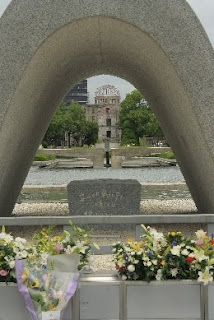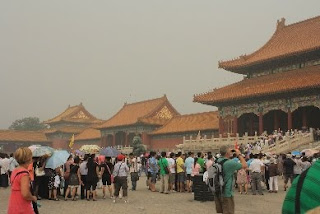My Return to Shanghai came with much better weather. A visit to the Bund water front and Nangjing Road on a Busy (understatement) Saturday night is a quick way to get reacquainted with its 16 million inhabitants.
One thing I missed the first time around was "Old Shanghai" which is a district of city blocks , small pedestrian streets and Ming dynasty traditional Chinese architecture. Or At least it appears to be. I later found that the District was built in the 1980's, raising some interesting questions. Because if it was in fact re-created to have that Traditional Chinese look, we are talking about something in authentic. But, the project is incredibly successful in that Chinese people absolutely love the place. I am torn on the subject, on one hand I think it is Hokey, on the other, tourist and locals a like enjoy it.
The 2010 Wold Expo is in Shanghai this summer, and as I may have said earlier , it is seemingly at the center of the world. Some may think it is not a big deal, But I must remind you of significance of the World Expositions. The
London Expo in 1851, Chicago 1893, and My Personal favorite 1915 San Diego which gave birth to modern day balboa Park, a jewel in the city.
The World Expo is a ground for cultural exchange, it is education and inspirational. And now, more then Ever, China and specifically Shanghai is showcasing its excellence. More over, shanghai has invited countries from around the world to donate their creativity, technology and innovation to share with the world.
The theme of the 2010 Expo is "Better City, Better life " , concentrating on the improvements of urban environments to help foster more sustainable growth in the 21st century. I found great interest in the less popular pavilions hosted by specific cities or projects that showcase built projects on the topic in the "Best Urban Practices zone," however one cannot ignore the great buzz and excitement surrounding the country pavilions. Many have waiting lines of 3-4 hours to get into the Pavilions. There is an average of 200,000- 300,000 guest every day at the Expo. 85% of them being Chinese. Maybe you can imagine the lines.
UK Pavillion
I was fortunate enough to be traveling with my grandmother at this point, and we found that if you are above a certain age ( I will not tell how old ; ) then you can bypass the long lines. Even with this "golden goose" it is impossible to see everything at the expo... it would take weeks. So I chose carefully.
Being from the USA, i had to see the USA pavilion ( normal wait time 2-3 hours) and I cannot say how generally disappointing this experience was. I have full intent of writing another article ( not for this blog) about this topic, and when i do I will make sure to share. I don't know where to begin my rant so I wont start. It just epitomizes everything Americans don't like about America.
uugghhh...
What's frustrating, is that Americans could produce the most amazing pavilion, we have great designers, but it was clearly handled by the wrong people.

Sweden Pavillion
EVERY other country, on the other hand, has so much culture and excitement injected into their pavilion. So many good examples of interactive media. It is so exciting and inspiring to see architecture being blended so well with these different forms of media. The whole experience just gets my mind running.

Denmark

Germany































